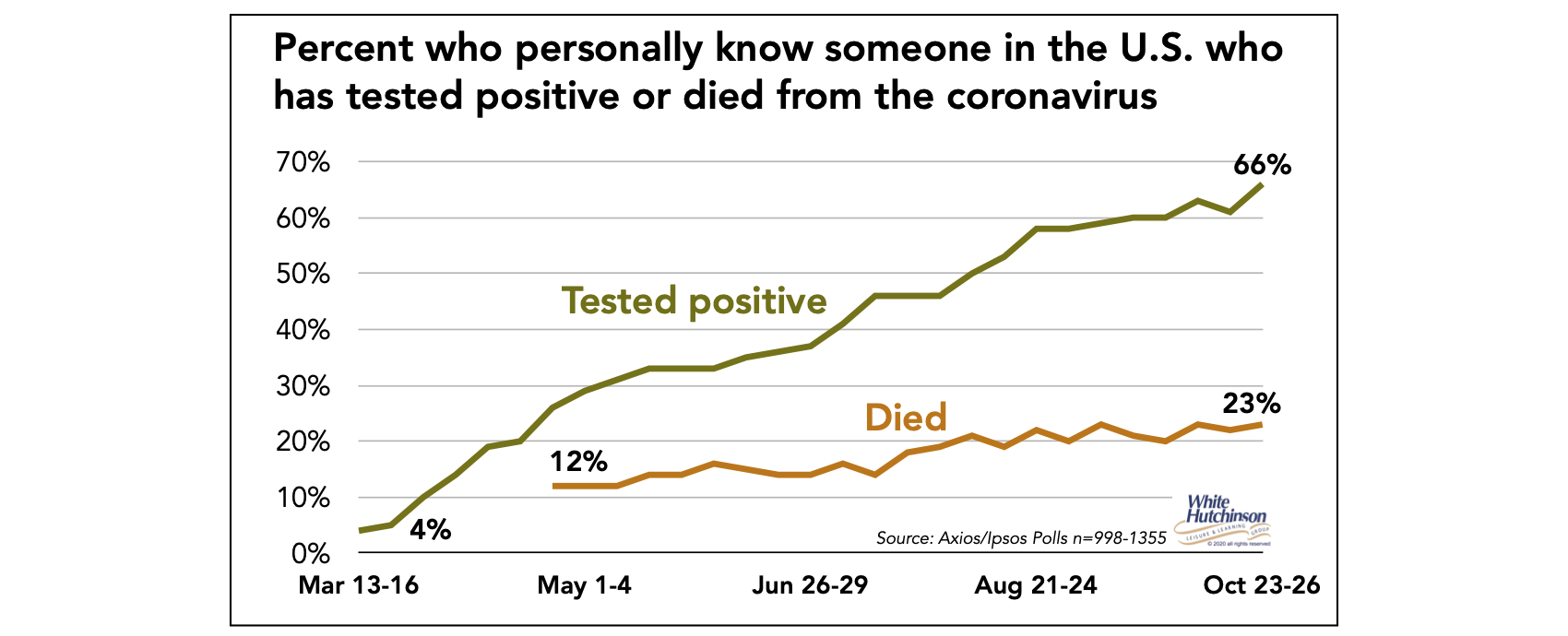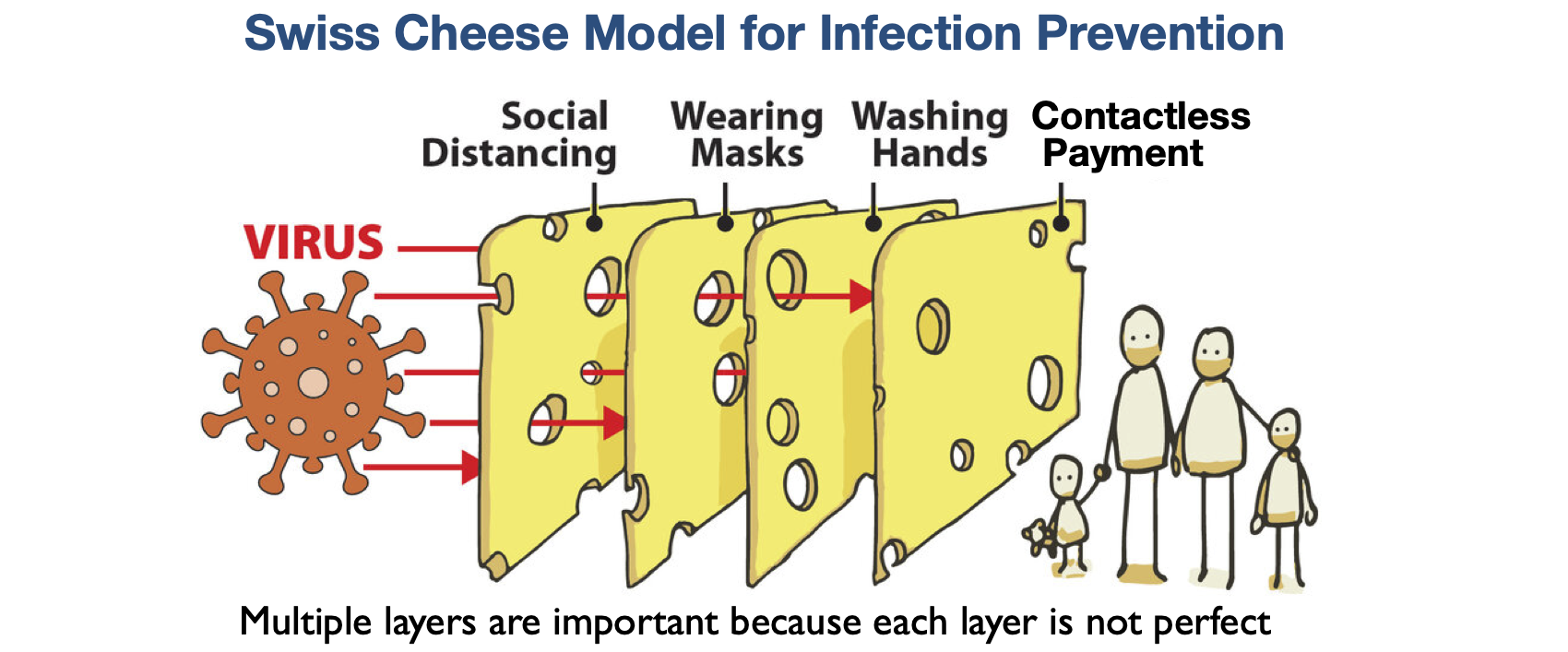The coronavirus is an existential threat for getting people to participate in public activities, including attending location-based entertainment venues (LBEs), such as FECs, and dining at restaurants.
Two-thirds of adults now know someone who has tested positive for the coronavirus (66%). Nearly one-quarter now knows someone who has died from the coronavirus (23%).

The October 8-12 HealthDay-Harris Poll of 2,021 U.S. adults found that more than half of adults (55%) say they know someone in their immediate or extended network of family and acquaintances who’ve been infected, hospitalized, or passed away from Covid-19. Nearly 2 in 5 people say they’ve had an even more direct experience with Covid-19, with either themselves or someone very close to them falling ill, hospitalized, or dying.
More than three-quarters of adults are currently concerned they or someone they know will be infected with Covid-19.

Nearly three-quarters of adults (74%) currently report that the coronavirus poses a very high to moderate threat to them personally. That is up from its low point during the pandemic in early June of only 6 in 10 (61%).

The HealthDay-Harris Poll found that people who’ve been personally affected by Covid-19 tend to see the pandemic differently from those who so far have remained relatively untouched by the virus. Those who have directly experienced Covid -19, either personally or through a loved one, are more likely to be very concerned that they or a loved one will die from Covid -19. Nearly two-thirds (64%) reported this high level of concern, versus one-half (52%) of those with no direct experience or whose only experience is through an acquaintance.
Adults whose personal experience with Covid -19 was more severe, with either themselves or a loved one struggling for life in a hospital or dying, were also more likely to be extremely worried about getting Covid -19 (78% versus 59%) and very concerned that they or a loved one will die from Covid -19 (73% versus 53%).
As the number of people who have had direct experience with Covid-19, either personally or with a family member or close friend, continues to increase, it is sure to heighten people’s concerns that they or a family member will catch the coronavirus by visiting a public activity, making them more reluctant about going. The most recent October 29-31 Morning Consult poll shows that only 41% of adults feel very or somewhat comfortable going out to eat at a restaurant, and less than one-quarter feel comfortable going to different types of LBEs. However, when asked if they would feel comfortable going in the next two weeks, only 28% said to a restaurant, only 11% to an amusement park, and only 14% going to a museum, which is consistently rated as the safest of all types of entertainment and cultural venues. The potential size market for LBEs and dining at restaurants has dramatically shrunk during the pandemic and may shrink further with the current surge in infections.
What can LBEs and restaurants do to maximize attendance by making their businesses perceived as safe as possible during the pandemic to attract people who aren’t very comfortable attending? It’s about how many slices of Swiss cheese they offer to reduce the risk. No, not literally serving Swiss cheese, but rather using the “Swiss Cheese Model.”
The Swiss Cheese Model was introduced in 1990 by James Reason, Ph.D., as a way to reduce accident risks. It was adopted to improve safety in many industries. Here’s how the model is applied to increase prevention from catching Covid-19.
Use your imagination to visualize a slice of Swiss cheese, a huge one about 8-foot-square, as the barrier between you and the coronavirus on the other side. The Swiss cheese has holes in it so that the virus can get through. Now add another slice of cheese. Not all the holes line up, and the 2nd slice blocks some holes in the first slice. Still, some holes fully or partially line up, so the evil virus can still get through to you. If you add enough slices, eventually you get to the point where there a no holes that the virus can penetrate to get through. The risk doesn’t go to zero as the virus might make an end run, but with multiple slices, you are a lot safer from catching the coronavirus.

At an LBE or restaurant, we don’t actually use giant slices of Swiss cheese to protect guests. Instead, the Swiss Cheese Model is about layering different measures of protection. Whereas one measure, such as social distancing, will reduce the risk of catching the coronavirus, it certainly doesn’t eliminate it. There is still a high risk of virus exposure. One slice of cheese, one measure on its own is imperfect, but using multiple layers together provides greater protection against catching Covid-19. The concept is that with enough layers, the holes are covered, and the opportunity for the virus to infect you is significantly reduced, not to zero, but very low.
Research on safety from catching Covid-19 has found these primary considerations:
- Indoors is riskier than outdoors
- Places that allow freedom of movement vs. fixed seating are safer as people have more control over their social distancing
- A greater length-of-stay increases the risk
- Communal high-touch experiences are riskier
- The greater the crowding, the greater the risk
- How clean and regularly disinfected the business is
- The behavior of both staff and visitors (are they wearing masks, are they social distancing, are they washing their hands, etc.)
From multiple polls in the LBE, restaurant, sports and cultural institution industries, I’ve compiled this list of the top “Swiss cheese” layers of protection that people indicate will make them feel safer from Covid-19 and more comfortable visiting public places:
- Mandatory face mask requirements for all guests and staff (except when eating/drinking)
- Required 6-foot physical distancing (spaced out tables at restaurants)
- All common high touch surface visibility wiped down/sanitized regularly
- Reduced/reconfigured seating and occupancy
- Hand sanitizer dispensers provided to guests
- Communicating all safety measures being taken
- Restrooms are immaculately clean and regularly cleaned
- Mandatory temperature checks for staff and guests*
- QSR or disposable paper menus
- Contactless payment available
- Installing air filtration systems
- Assurance that guest-facing staff are regularly tested for Covid-19
- Plexiglass dividers/sneeze guards at all POS & food pickup areas
- No condiment bottles on restaurant tables
Think of each measure as a slice of Swiss cheese. Each time another slice is added, the risk of infection reduces, and peoples’ comfort of visiting increases. I consider the first seven measures in the above list as the minimum table stakes for an LBE. For a restaurant or dining area in an LBE, some food and beverage-specific measures should be added for table stakes.
Here is a fantastic visualization of how the coronavirus might spread in different settings and with various interventions. Unsurprisingly, the more layers of precautions, the better

Of all the different layers of protection, the surveys consistently show that mandatory mask requirements and reduced capacity offer the greatest comfort to reluctant people.
To be as effective as possible to maximize attendance, mask-wearing needs to be mandatory, a zero-tolerance policy – no exceptions for anyone when it comes to mask-wearing. The vast majority of people understand that it isn’t the mask you wear that gives you the most protection from catching the coronavirus; it’s the masks everyone else is wearing that does. Although none of the other people may show any infection symptoms, some may be asymptomatic; they have the virus and are shedding it. If just one person in a crowd is not wearing a mask that sends the signal to people the environment is not safe. Click here to see a visualization of how masks work.
The Pew Research Center found that 15% of Americans expressed frustration that other people are not wearing a mask or refusing to follow safety precautions more generally. Datassential, in their surveys, found that nearly three-quarters of people (72%) don’t trust others to act responsibly at businesses. An October 9-11 survey by Destination America found that for 8 in 10 American travelers, the top two protocols that would be important or very important to their decision to travel by air were mandatory face masks and enforced social distancing. Concern that not everyone at an LBE or restaurant is wearing a mask can be a significant deterrent for many people. That is why a mandatory mask requirement should be strictly enforced to maximize attendance; no different than airlines are doing to maximize flyers.
The degree of social distancing resulting from reduced capacity has a dramatic effect on people’s comfort. One study found that for restaurants, as the capacity of the restaurant was reduced, people increased their likelihood to visit. At 100% occupancy, 3 in 10 adults said they were very or somewhat likely to dine in at a restaurant. That increased to 5 in 10 when capacity was reduced to 25%.

In a previous blog, I cited a poll on comfort visiting concerts. For an indoor concert at 100% capacity, one-third of regular concert attendees (33%) said they would be very or somewhat comfortable attending. That nearly doubled and increased to 6 in 10 regular attendees (60%) when capacity decreased to 25%. That same increased comfort with reduced capacity was found for outdoor concerts.
The bottom line to attract the greatest number of guests during the pandemic is to offer as many slices of Swiss cheese, measures of protection, as possible. And just as important is to be transparent and clearly communicate all the actions in your marketing and to attending guests.
*note on temperature checks – Although temperature checks for guests and staff show up on many surveys as a protocol that will make people more comfortable, they do little to screen out infected people. Research is finding that the vast majority of infections are spread by pre-symptomatic or asymptomatic people, who thus have no fever. Nevertheless, since many people consider them a layer of protection, they can still be one of the slices of cheese offered.
Follow me on Twitter and Linkedin – I try to post news and information relevant to the location-based leisure, LBE and FEC industries a few times every weekday.
To subscribe to this blog, click here



